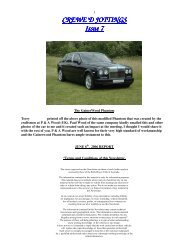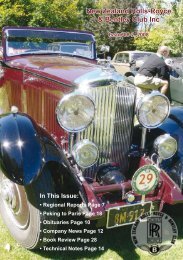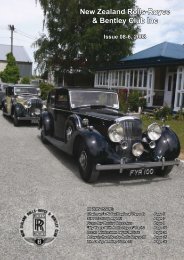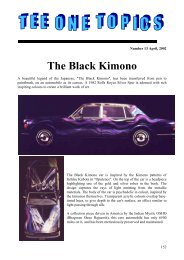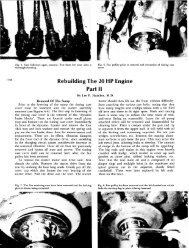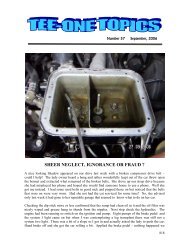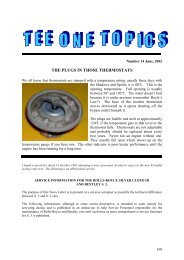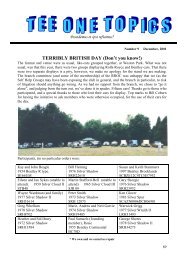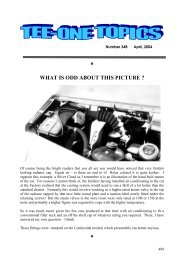February 2012 Newsletter - KDA132
February 2012 Newsletter - KDA132
February 2012 Newsletter - KDA132
You also want an ePaper? Increase the reach of your titles
YUMPU automatically turns print PDFs into web optimized ePapers that Google loves.
Twenty Topics by Dr David Davis<br />
(Reprinted from Præclarvm 12-1 with the permission of the Author and Editor)<br />
The NZ Rolls-Royce & Bentley Club Magazine 11-6 has an article<br />
about fitting 4 wheel hydraulic brakes to an early 20hp GA69.<br />
The story of how it was done is fascinating. A later front axle<br />
has been used with the internals replaced with wheel cylinders<br />
hydraulically linked to the brake pedal. Two separate master<br />
cylinders with slave cylinders operate the rear brakes through<br />
the existing levers. The installation required a lot of meeting<br />
problems as they arose including the lubrication arrangements<br />
for the front axle. I wonder if the hydraulics would lock the rear<br />
brakes especially in the wet which is the main objection to 2 wheel<br />
brakes. I suppose it would be a matter of balance between the front<br />
and back. The modification passed compulsory certification.<br />
There are two other front brake conversions that I know of being<br />
76A5 which has had motor bike disc brakes fitted to the front<br />
which involved machining new hubs. I understand that the pads<br />
wear quickly due to the weight of the car. The other conversion is<br />
Jim Kelso’s GRK81 which now has vacuum assistance applied to<br />
the brakes including the RR front axle fitted many years ago by<br />
Patrick Kane White .GF8, has vacuum assistance applied to its 2<br />
wheel brakes which work well in dry weather but readily locks the<br />
wheels in the wet.<br />
Early in my ownership of 42G1, I asked Bert Ward should I fit<br />
An excuse to publish photographs of three “Twenties” active here:<br />
(clockwise from above) Philip Eilenberg’s Hooper bodied GEN39;<br />
Mulliner Weymann Saloon with Division GFN49, cared for by<br />
John Ferguson; and GTM28, James Young Drop-head Coupé<br />
from 1934 replacing the 1928 Melhuish Tourer body, owned by<br />
Vicky Ellis<br />
front brakes to the car. Bert’s response was that, properly adjusted,<br />
2 wheel brakes were more than adequate. After I had driven two<br />
Silver Ghosts with 2 wheel brakes namely 45NA and 56 AG both<br />
of which were great, I appreciated that he was right.<br />
Early cars with A steering, such as Jim’s, have a special problem<br />
as the forward seating position necessitates downward pressure<br />
on the brake pedal rather than outward leg pressure as is the case<br />
with D. The seating position on the latter is further away from the<br />
pedal under the lower raked steering wheel. Clearly, nowhere near<br />
as much comfortable pressure can be applied to the pedal in the<br />
case of A steering as can be in the case of D. I can understand, then,<br />
why there is a perception that A steering cars have a problem.<br />
There is no doubt that the fitting of front brakes to a Twenty,<br />
involves assistance as the pressure required to operate 4 brakes<br />
effectively, is beyond leg strength which is a point raised by Bert.<br />
I have always been wary of the RR servo system as reversing can<br />
be unpredictable as can ahead, unless holding the wheel firmly.<br />
There is a full discussion on the RR servo system in Fundamentals<br />
of Car Performance by Hives etc including these issues which<br />
relate to adjustment. That book also comments on the differences<br />
between 2 and 4 wheel brakes noting that 60% of braking in the<br />
servo system is taken up by the rear brakes the performance of<br />
which in both systems is directly related to the proportion of the<br />
car’s weight over the rear wheels. The book points out that, in<br />
the end, it is all about tyre adherence to the road surface. The<br />
book notes that the greatest retardation achieved in tests was<br />
20ft/second, squared and that the limit for personal comfort of the<br />
passengers in the rear of the car was 12ft/second, squared.<br />
The vacuum assistance fitted to Jim’s car is effective and I would<br />
say is more predictable than the RR servo. Of course the engine<br />
has to be running for it to work which is not the case with the RR<br />
system. It is interesting to note that the Springfield Factory retrofitted<br />
vacuum brakes to Silver Ghosts, and a Canadian owner of<br />
both Rolls-Royce and vacuum types, commented to me that he<br />
preferred the vacuum.<br />
The fitting of front brakes to an early car involves other<br />
considerations besides assistance including whether king posts<br />
and struts should be added to the bottom of the chassis frame to<br />
counter braking stresses and whether changes need to be made to<br />
the front springs to counter windup under braking which affects<br />
steering. There is a discussion of the latter in Fundamentals of Car<br />
Performance which explains why 4 wheel braked Twentys have<br />
longer front springs.<br />
Looking back over my ownership of 42G1, as Paul Samuels<br />
commented when he owned the car, the brakes were hopeless. The<br />
issue was the brakes seeming to not work at all followed by lock<br />
up. Replacing the heavy body helped matters but a significant<br />
improvement resulted from mounting the spare wheel at the back<br />
which stopped the wheels from locking up especially in the wet.<br />
Curing a differential oil leak followed by a complete overhaul<br />
including softer linings which have a more progressive action, has<br />
resulted in effective brakes in which I have every confidence.<br />
David G Davis 42G1 NSW<br />
NZRR&BC Issue 12-2 16



